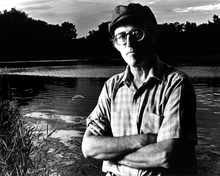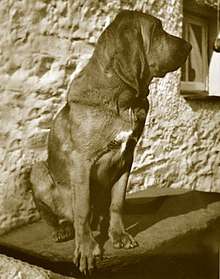Eville Gorham
| Eville Gorham | |
|---|---|
 Gorham in 1984 | |
| Born |
15 October 1925 Halifax, Nova Scotia, Canada |
| Residence | USA |
| Citizenship | Canada, US |
| Alma mater |
Dalhousie University University College London |
| Known for | Studies of acid rain, peatlands, radioactive fallout |
| Awards |
Regents' Medal, University of Minnesota Benjamin Franklin Medal[1] G. Evelyn Hutchinson Award[2] Lifetime achievement award, Society of Wetland Scientists |
| Scientific career | |
| Fields | Ecology, Limnology, Biogeochemistry |
| Institutions |
University College, London (lecturer) Freshwater Biology Association, United Kingdom (Senior Scientific Officer) University of Toronto (Assistant Professor) University of Calgary (Professor, Department of Biology) University of Minnesota (Regents' Professor, Department of Ecology) |
| Doctoral advisor | W. H. Pearsall |
Eville Gorham (PhD LlD DSc FAAAS FRSC MNAS FESA) is a Canadian-American scientist whose focus has been understanding the chemistry of fresh waters[3] and the ecology and biogeochemistry of peatlands.[4] In the process, Gorham made a number of practical contributions that included discovering the influence of acid rain in lake acidification,[5][6] plus the importance of the biological magnification of radioactive fallout isotopes in northern food chains.[7][8][9][10] The former led to legislation and redesign of the power plants of the world to scrub sulfur, and the latter was an early step toward the establishment of an atmospheric nuclear test ban treaty.
Gorham emphasizes that discovery in science is often the result of chance and serendipity, and encourages students to watch for the opportunities that chance provides.[11] He was recognized by the National Academy of Sciences[12] as a renaissance scholar[13] and has influenced the careers of others.[14]
Life and career
Eville Gorham grew up in Halifax, Nova Scotia, an avid reader drawn to the classroom. His life and career are outlined in a 2015 essay.[15] He attended Dalhousie University from 1942 to 1947, receiving a BSc degree in biology and an MSc degree in zoology. His thesis showed the effects of temperature difference in the development of salmon embryos,[16] of later significance for studies of thermal pollution.
At this point, Gorham decided to avoid experimentation that involved harming animals. In 1947, he received an Overseas Science Research Scholarship from the Royal Commission for the Exhibition of 1851 and was accepted as a doctoral student of plant ecology at University College, London.
Gorham began his doctoral work studying mineral content of plants in the Lake District and became interested in the acidification of ecosystems. After his PhD, he spent a postdoctoral year in Sweden conducting a project on the waters of a Swedish peatland. After returning to England, he worked first as a Lecturer in Botany at University College, London and later for the Freshwater Biological Association in the English Lake District. It was here that he made some of his most significant discoveries regarding acid rain and nuclear fallout.

Gorham credits his discoveries in radioactive fallout to the milkshakes at a drugstore in Halifax. He became fond of the proprietor’s bloodhound, and, in a point of serendipity, his later search for his own bloodhound led to an opportunity to research radioactivity. It led him to the local medical officer, Frank Madge, who had a bloodhound. Madge became concerned about implications for the surrounding population after a fire at the Windscale plutonium plant in the Lake District, and asked Gorham to assist in his investigation. Gorham eventually agreed to use his lab’s Geiger counter to investigate radiation around the plant. He discovered major radiation in sphagnum moss gathered from near the Windscale site, but equivalent radiation in sphagnum gathered far from the site. This suggested that the radiation was not the result of the Windscale fire, but rather was global radioactive fallout. Gorham wrote a paper about his findings and sent it to Nature for review. It was published as the lead article.
Gorham continued to test radioactivity in plants and discovered that lichens were also highly radioactive. Moreover, he chanced to read a brief paragraph in a report from the Norwegian Defense Reserve Establishment, which noted that Norway reindeer, which eat lichen, were unusually rich in radioactive elements. Gorham then published an article that indicated the extreme bioaccumulation of radioactive fallout in northern ecosystems. This information laid the groundwork for Barry Commoner, leader of the St. Louis Committee for Nuclear Information, to suggest that, because reindeer picked up radioactivity from lichen, their primary food source, that radioactivity could be passed along and concentrated further in the Inuit and Laplander people who ate those reindeer. In mid-twentieth century, the idea that human actions could permeate the entire globe, including people remote from the initial problem, helped encourage the Atmospheric Nuclear Test Ban Treaty of 1963, which prohibited nuclear testing in the atmosphere. Gorham’s applied work with radioactivity was just a side project, although one with notable global consequences. His main focus in the Lake District was the pure science of the chemistry of rain, bog, and lake waters. He tested and proved Margaretta Witting’s hypothesis that bog waters are largely composed of rainwater. However, Gorham discovered that the contents of the rainwater were not only local. When the wind was from industrial areas, even in rural areas the rain was dilute sulfuric acid, while wind from the coast brought sea-salt rain. Thus began Gorham’s second side project in applied science, also with notable global consequences. His findings showed far-reaching effects of air pollution. Angus Smith had discovered acid rain in the nineteenth century, but it was restricted to urban/industrial areas; his results subsequently had then been lost to science.
Continuing these applied projects, Gorham turned attention to the effects of air pollution on humans, and discovered correlations between three lung diseases and different air pollutants. Bronchitis was common in urban/industrial areas, correlated with hydrochloric acid, which falls out near its source and therefore largely caused problems in cities. Pneumonia was correlated with sulphur in the rain, which was eventually found to be the result of sulphate particles in the air. Lung cancer was correlated with tar emitted to the air by industrial plants. This resulted in two publications in the British medical journal The Lancet and one in The Medical Officer. After the death of his father, Gorham and family returned to Canada, where he took a position in the botany department position at the University of Toronto. With Alan Gordon, he studied the effects of smelter pollution on the forests and lakes around Sudbury, Ontario. Then in 1962, he accepted a position at the University of Minnesota. It was here that Gorham took up environmental activism and developed courses on the ecological effects of pollution upon ecosystems. Gorham served on multiple environmental committees, including the joint Canadian-U.S. scientific commission under President Carter,[17] and took part in many environmental projects, such as those sponsored by the Royal Society of Canada and U.S. Academy of National Sciences, including peatlands,[18] and research trends in ecology (in review) and limnology (in progress).
Personal life
In 1948, Gorham married Ada MacLeod, whom he had met while she was researching child nutrition at Dalhousie. They then had four children: Kerstin, Vivien, Jocelyn, and James.
Selected works
References
- ↑ Platt, Lucian (2000). "The 2000 Benjamin Franklin Medal in Earth Science presented to Eville Gorham". Journal of the Franklin Institute. 337 (7): 813–816. doi:10.1016/S0016-0032(00)00058-2.
- ↑ Nixon, Scott W. (1987). "Hutchinson Award to Eville Gorham". Eos, Transactions American Geophysical Union. 68: 199. Bibcode:1987EOSTr..68..199N. doi:10.1029/eo068i014p00199-01.
- ↑ Gorham, Eville (1961). "Factors influencing the supply of major ions to inland waters, with special reference to the atmosphere". Geological Society of America Bulletin (76): 795–840. doi:10.1130/0016-7606(1961)72[795:fisomi]2.0.co;2.
- ↑ Gorham, Eville (1991). "Northern peatlands: role in the global carbon cycle and probable responses to climatic warming". Ecological Applications (1): 182–295. doi:10.2307/1941811.
- ↑ Gorham, Eville (1955). "On the acidity and salinity of rain". Geochimica et Cosmochimica Acta. 7: 231–239. doi:10.1016/0016-7037(55)90034-x.
- ↑ Schobert, Harold H. (2014). Energy and Society: An Introduction, Second Edition. CRC Press. p. 478ff.
- ↑ Gorham, Eville (1958). "Accumulation of radioactive fallout by plants in the English Lake District". Nature. 181: 152–154. doi:10.1038/1811523a0.
- ↑ Gorham, Eville (1959). "A comparison of lower and higher plants as accumulators of radioactive fallout". Canadian Journal of Botany. 37: 327–329. doi:10.1139/b59-023.
- ↑ Kaufman, Scott (2013). Project Plowshare: The peaceful use of nuclear explosives in Cold War America. Cornell University Press. p. 76.
- ↑ Young, Wayne (2014). "Life in the fast lane– what's the rush?". The Guardian, Charlottetown Newspaper.
- ↑ Gorham, Eville (2012). "Two contrasting approaches to ecological research". Ecological Society of America Bulletin. 93: 298–302. doi:10.1890/0012-9623-93.4.298.
- ↑ https://www.fi.edu/laureates/eville-gorham
- ↑ National Academy of Sciences (1995). "Presentation Ceremony". Proceedings of the 132nd Annual Meeting. 123.
- ↑ Vitousek, Peter (2014). "Insightful, scholarly, and synthetic: Eville Gorham and the chemistry of surface waters". Bulletin of the Ecological Society of America. 95: 226–228. doi:10.1890/0012-9623-95.3.226.
- ↑ Gorham, Eville (2015). "Reflections on life in a deteriorating world: How chance made me an environmental activist". Journal of Opinion, Ideas, and Essays (online). 2: 1–15.
- ↑ Hayes, Ronald F.; Pelluet, Dixie; Gorham, Eville (1953). "Some effects of temperature on the embryonic development of the salmon (Salmo salar)". Canadian Journal of Zoology. 31: 42–51. doi:10.1139/z53-005.
- ↑ Hayes, Samuel (Feb 1, 1998). Explorations in Environmental History: Essays. Pittsburgh, PA: University of Pittsburgh Press. p. 281.
- ↑ Gorham, Eville; Lehman, Clarence; Dyke, Art; Clymo, Dickie; Janssens, Jan (2012). "Long-term carbon sequestration in North American peatlands". Quaternary Science Reviews. 58: 77–82. doi:10.1016/j.quascirev.2012.09.018.
External links
- Eville Gorham, University of Minnesota, College of Biological Sciences
- Collected works, Digital Conservancy
- Citations to works, Google Scholar
- Interview, with S. Mandaville, In Harmony with Nature
- Interview, with Clarke Chambers
- Interview, with C. Lehman, University of Minnesota
- Honorary doctorate, University of Minnesota
- Franklin Institute
- Summary of Career